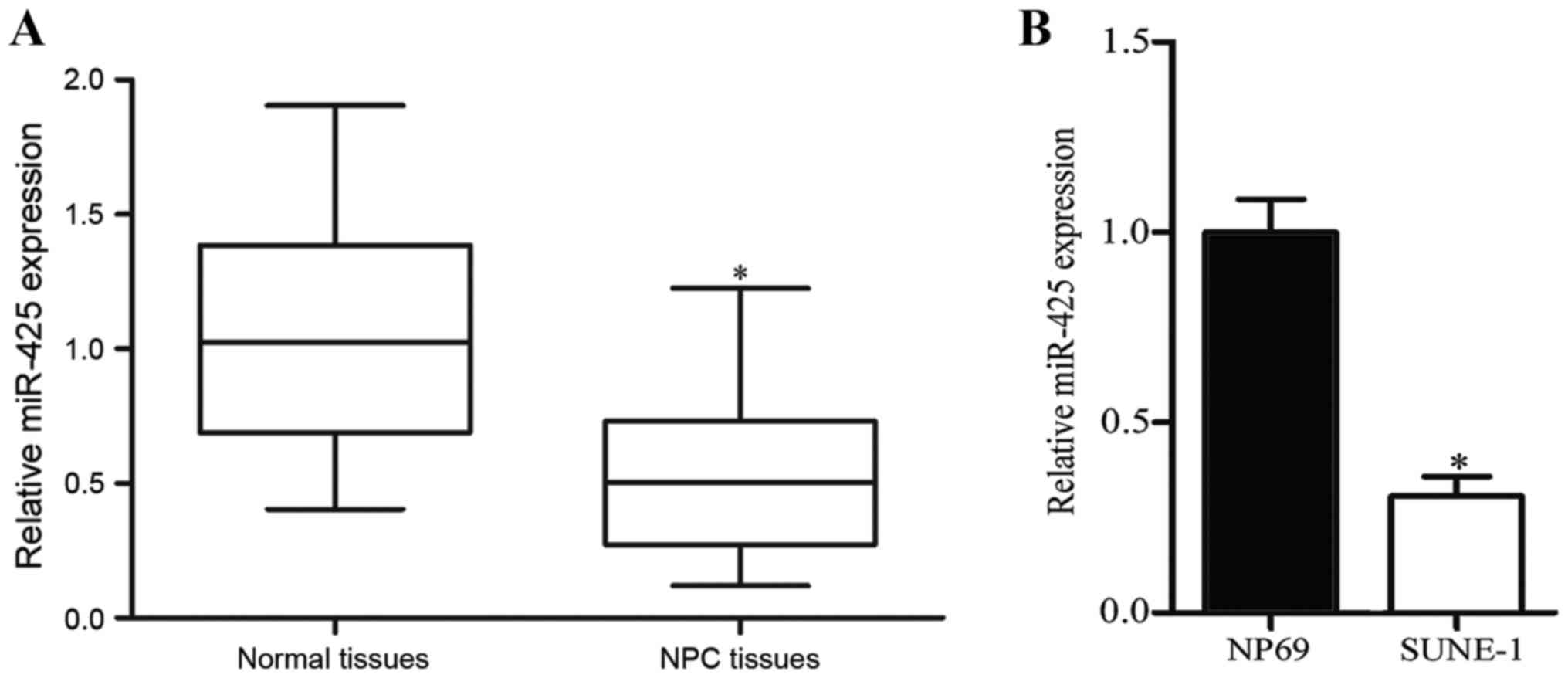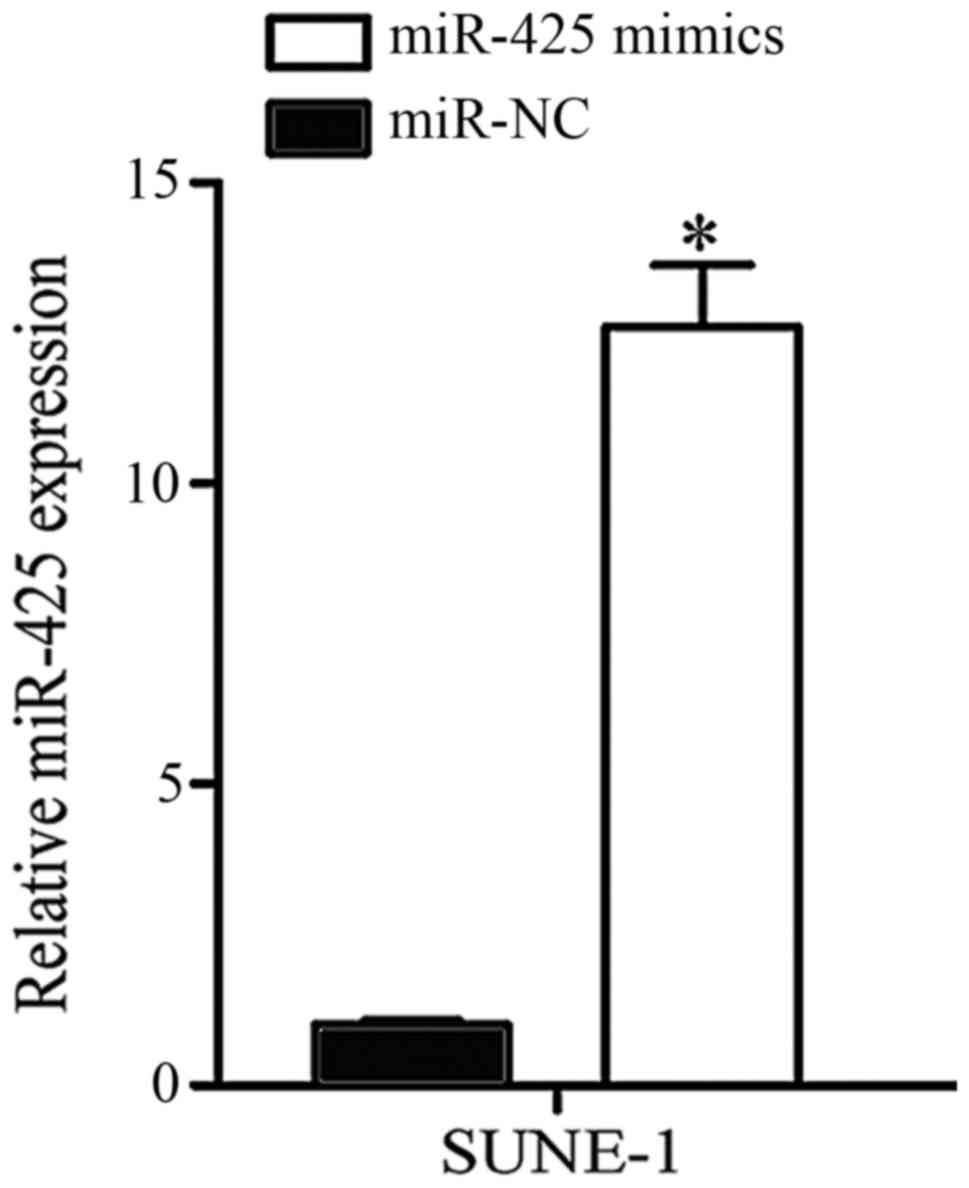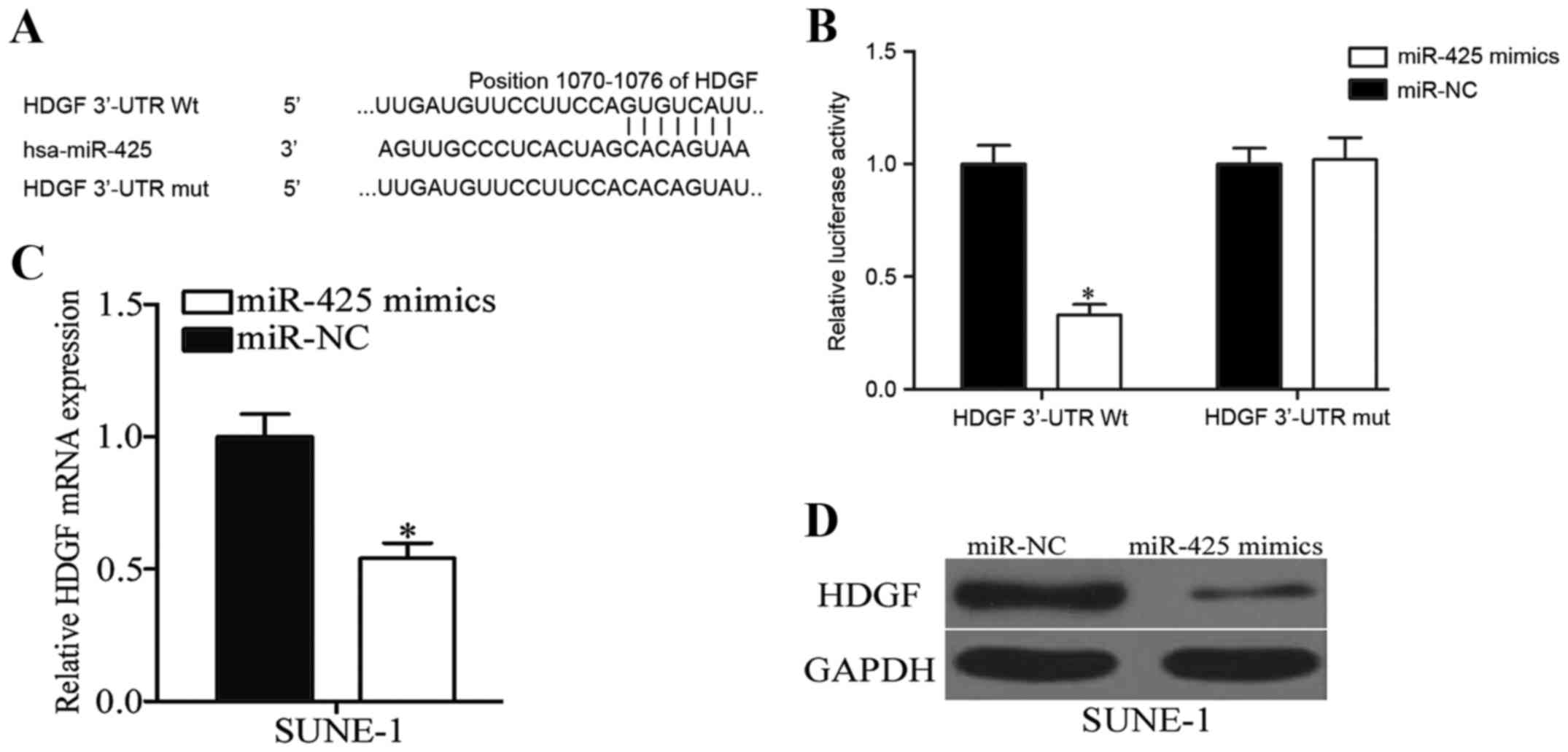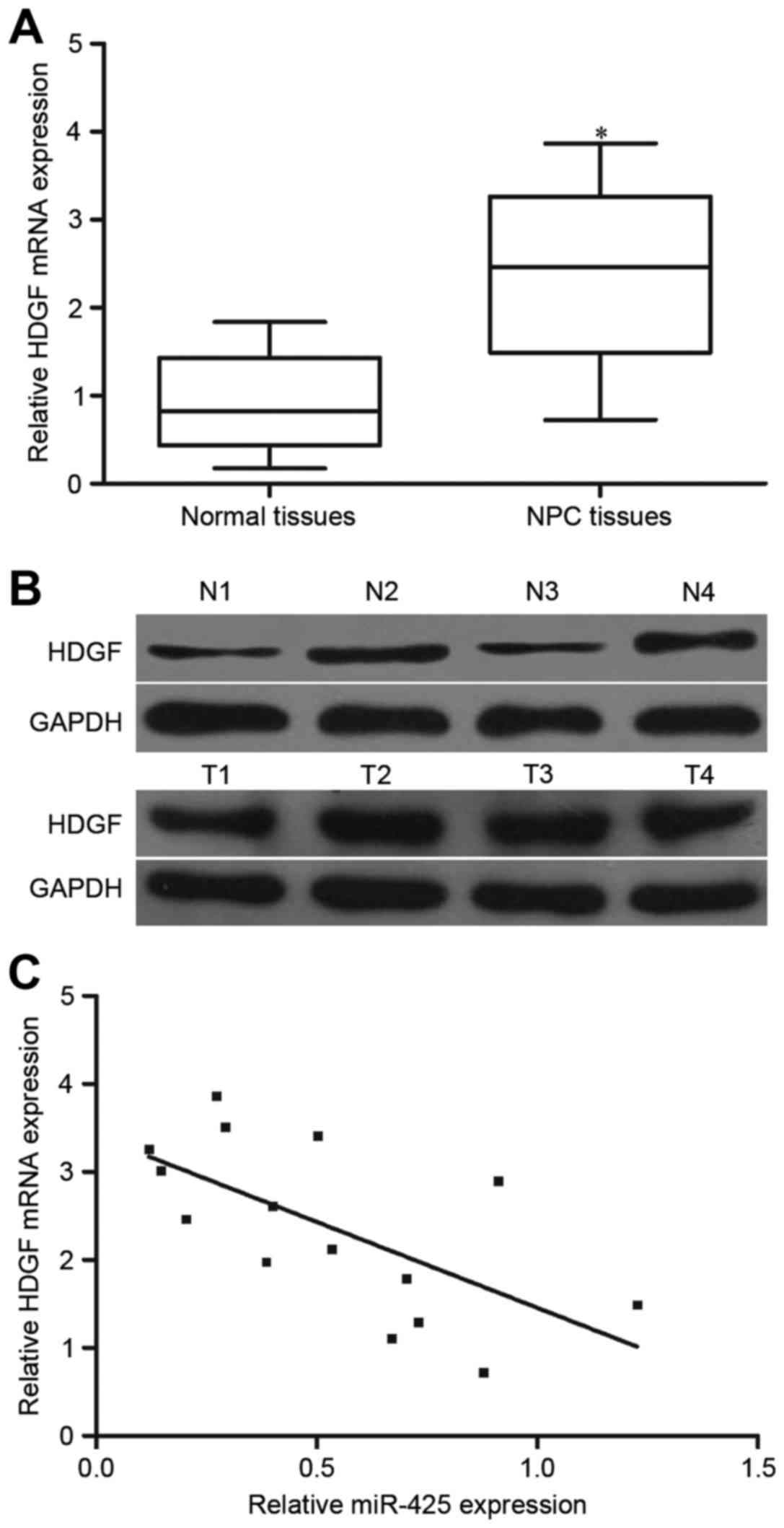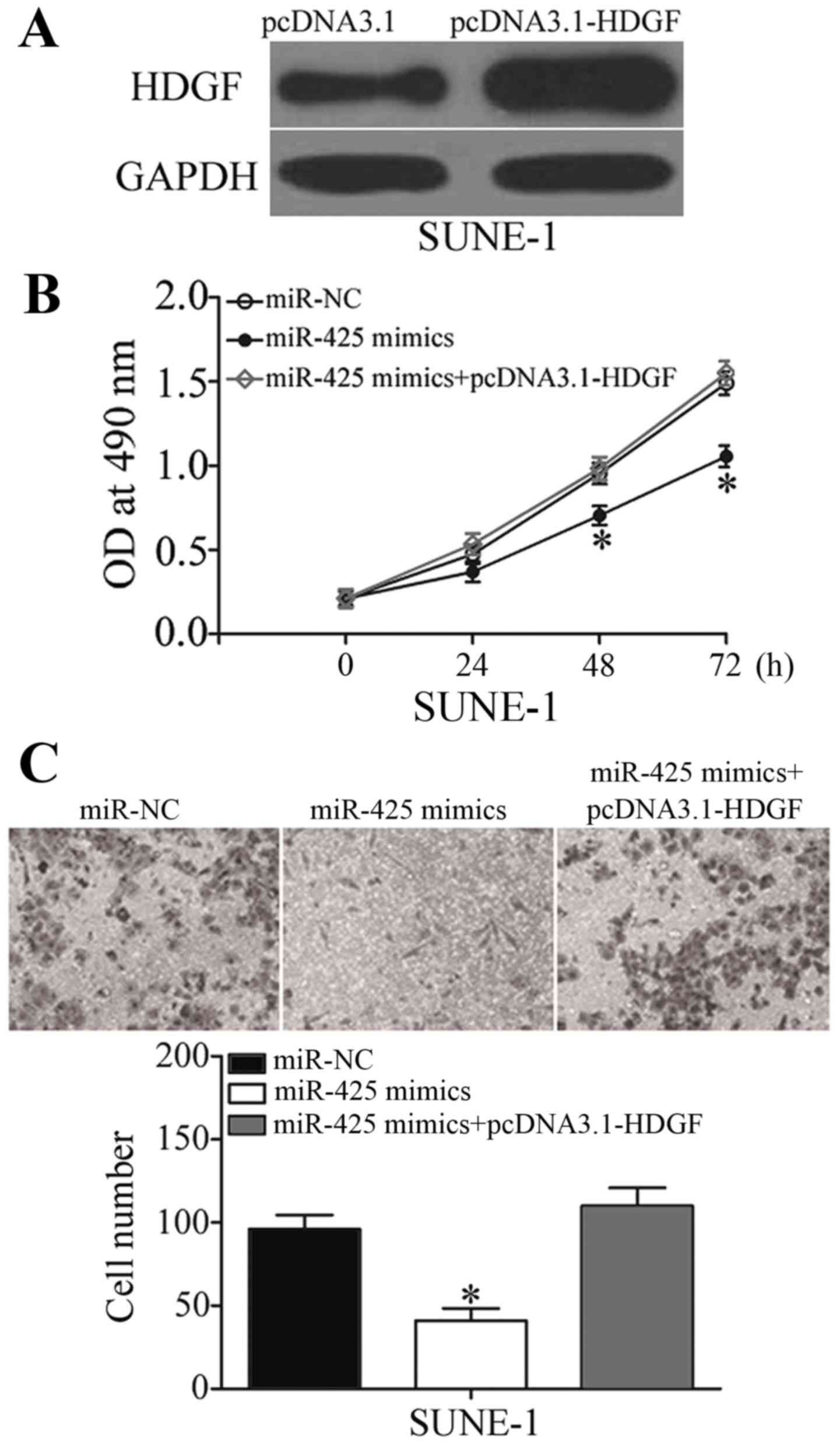MicroRNA-425 is downregulated in nasopharyngeal carcinoma and regulates tumor cell viability and invasion by targeting hepatoma-derived growth factor
Retraction in: /10.3892/ol.2024.14245
- Authors:
- Published online on: February 27, 2018 https://doi.org/10.3892/ol.2018.8128
- Pages: 6345-6351
-
Copyright: © Zhu et al. This is an open access article distributed under the terms of Creative Commons Attribution License.
Abstract
Introduction
Nasopharyngeal carcinoma (NPC), which arises from the nasopharynx epithelium, is most common in Southeast Asia, particularly in Southern China (1). A previous study demonstrated that genetic susceptibility, environmental factors and Epstein-Barr virus latent infection are key risk factors in the pathogenesis of NPC (2). Despite considerable progress having been made in multimodal treatments, the prognosis of patients with NPC remains unsatisfactory (3). The 5-year survival rate of NPC cases at I/II stage is 72–90%, however the rate markedly decreases to <55% in patients at III/IV stage (4). The key causes for poor prognosis of patients with NPC are local recurrence and metastasis (5,6). In addition, ~70% of patients being diagnosed at late stages with cervical lymph node metastasis is also a cause of treatment failure in patients with NPC (7). Therefore, elucidating the underlying molecular mechanisms of NPC initiation and progression is required, as well as the identification of novel therapeutic targets for the treatment of patients with NPC.
The discovery of microRNAs (miRNAs) established a novel method for targeted therapy. miRNAs are a large family of conserved, single-stranded 21–23 nucleotide-long non-protein-coding RNA molecules (8). These small RNAs act crucial gene regulators at the posttranscriptional level by binding to the 3′-untranslated region (3′-UTR) of their target genes, and thereby resulting in either modulation of translation efficiency or degradation of the target mRNAs (9,10). miRNAs have been demonstrated to be involved in various cellular biological processes, including proliferation, cell cycle, apoptosis, differentiation, metabolism, motility and angiogenesis (8,11,12). It has been widely established that a single miRNA may be able to target hundreds of mRNAs, and ~50% of miRNAs are located at cancer-associated chromosomal regions (13). Abnormally expressed miRNAs have been observed in the majority of tumor types, including NPC (14–16). miRNAs may act as either a tumor suppressor or oncogene in human cancer, depending on the functions of their target genes (17,18). Therefore, it is important to investigate the deregulated expression of miRNAs and their functions in NPC in order to provide effective and novel therapeutic targets for antitumor therapy.
miR-425 has previously been reported to be frequently abnormally expressed in a number of different types of human cancer (19–21). However, to the best of our knowledge, the expression pattern and biological effects of miR-425 in NPC have yet to be elucidated. The aim of the present study was to investigate the expression levels of miR-425 in NPC tissues and cell lines. Additionally, its functions and underlying molecular mechanisms in NPC were explored.
Materials and methods
Ethical statement and tissue samples
The present study was approved by the Ethical Committee of Huai'an First People's Hospital (Huai'an, China). All patients provided written consent and were informed of the purposes of the study. A total of 15 nasopharyngeal carcinoma tissues were obtained from patients (9 males, 6 females; age range, 32–67 years) who underwent surgical resection at the Department of Otolaryngology Head and Neck surgery, Huai'an First People's Hospital between July 2014 and January 2016. In addition, 10 normal nasopharyngeal tissues were collected from biopsy-negative cases from the same location. None of the patients received any pre-operative chemotherapy or radiotherapy. All tissue samples were immediately frozen in liquid nitrogen and stored at −80°C for further study.
Cell lines and culture condition
The human NPC cell line SUNE-1 and normal nasopharyngeal epithelial cell line NP69 were obtained from American Type Culture Collection (ATCC; Manassas, VA, USA). NPC cells were cultured in Dulbecco's modified Eagle's medium (Gibco; Thermo Fisher Scientific, Inc., Waltham, MA, USA) containing 10% fetal bovine serum (FBS; Gibco; Thermo Fisher Scientific, Inc.) and 1% antibiotics (100 U/ml penicillin and 100 mg/ml streptomycin sulfates). NP69 cells were cultured in keratinocyte serum-free medium (Thermo Fisher Scientific, Inc. supplemented with 30 µg/ml bovine pituitary extract (BD Biosciences, Franklin Lakes, NJ, USA). All cells were maintained in an incubator at 37°C, with 90% humidity and 5% CO2.
Oligonucleotide transfection
The miR-425 mimics and negative control miRNA mimics (miR-NC) were purchased from Guangzhou RiboBio Co., Ltd. (Guangzhou, China). The miR-425 mimics sequence was as follows: 5′-AAUGACACGAUCACUCCCGUUGA-3′ and the miR-NC sequence was as follows: 5′-UUCUCCGAACGUGUCACGUTT-3′. pcDNA3.1-HDGF and pcDNA3.1 blank vectors were synthesized by Chinese Academy of Sciences (Changchun, China). For cell transfection, NPC cells were seeded in 6-well plates at a density of 60–70% confluence 18–24 h prior to transfection. Lipofectamine® 2000 (Invitrogen; Thermo Fisher Scientific, Inc.) was used for transfection, according to manufacturer's instructions. miR-425 mimics (100 pmol) were transfected into cells in order to overexpress miR-425, whereas pcDNA3.1-HDGF (4 µg) was transfected into cells to increase HDGF expression.
RNA extraction and reverse transcription-quantitative-polymerase chain reaction (RT-qPCR)
Total RNA was isolated from tissue samples and cell lines using TRIzol reagent (Thermo Fisher Scientific, Inc.) and the expression of total RNA was determined using Nanodrop 2000 (Thermo Fisher Scientific, Inc.). For miR-425 expression, TaqMan MicroRNA Reverse Transcription Kit (Applied Biosystems; Thermo Fisher Scientific, Inc.) was used to synthesize cDNA. The thermocycling conditions were as follows: 16°C for 30 min, 42°C for 30 min and 85°C for 5 min. Expression of miR-425 was examined using TaqMan MicroRNA PCR kit (Applied Biosystems; Thermo Fisher Scientific, Inc.), according to the manufacturer's instructions. To quantify HDGF mRNA expression, reverse transcription was conducted using PrimeScript RT reagent kit and HDGF mRNA was amplified using SYBR Premix Ex Taq (both from Takara Biotechnology Co., Ltd., Dalian, China), according to the manufacturer's instructions. The temperature protocol for reverse transcription was as follows: 37°C for 15 min and 85°C for 5 sec. U6 and β-actin were used as internal control for miR-425 and HDGF, respectively. The PCR primers used in the present study were as follows: miR-425 forward, 5′-ACACTCCAGCTGGGAATGACACGATCACTCC-3′ and reverse, 5′-TGGTGTCGTGGAGTCG-3′; U6 forward, 5′-CTCGCTTCGGCAGCACA-3′ and reverse, 5′-AACGCTTCACGAATTTGCGT-3′; HDGF forward, 5′-ATCAACAGCCAACAAATACC-3′ and reverse, 5′-TTCTTATCACCGTCACCCT-3′; β-actin forward, 5′-ATTGCCGACAGGATGCAGAA-3′ and reverse, 5′-CAAGATCATTGCTCCTCCTGAGCGCA-3′. Fold-changes for miR-425 and HDGF mRNA expression levels were calculated using the 2−ΔΔCq method (22).
MTT assay
Cell viability was evaluated using an MTT assay (Sigma-Aldrich; Merck KGaA, Darmstadt, Germany). Briefly, 3×103 cells/well were plated in a 96-well plate and then transfected with miR-425 mimics, miR-NC, pcDNA3.1-HDGF or pcDNA3.1, as aforementioned. Following incubation for 0, 24, 48 or 72 h at 37°C and 5% CO2 the MTT assay was performed. A total of 20 µl MTT (5 mg/ml) was added into each well and incubated at 37°C for another 4 h. The culture medium was removed and 150 µl dimethyl sulfoxide (Sigma-Aldrich; Merck KGaA) was added into each well. The optical density was determined at a wavelength of 490 nm using a microplate reader (BioTek Instruments, Inc., Winooski, VT, USA).
Transwell cell invasion assay
Transwell cell invasion assays were performed to evaluate the invasive capacity of NPC cells. Following 48 h of transfection, 5×104 cells in 100 µl FBS-free culture medium were seeded into Transwell upper chamber (24-well insert; pore size, 8 µm; Corning Inc., Corning, NY, USA) coated with Matrigel (BD Biosciences). Culture medium with 20% FBS was used in the lower chamber as the attractant. Following incubation for 48 h, cells remaining on the upper surface were mechanically removed with a cotton swab. The invasive cells were fixed in 100% methanol at room temperature for 15 min and stained with 0.5% crystal violet at room temperature for 15 min. Cell numbers were obtained from five fields per membrane under a light microscope (×200 magnification; Olympus Corporation, Tokyo, Japan).
Western blotting
Primary antibodies used in the present study included mouse anti-human monoclonal HDGF (sc-398344; 1:1,000 dilution) and mouse anti-human monoclonal GAPDH (sc-32233; 1:1,000 dilution) (both from Santa Cruz Biotechnology, Inc., Dallas, TX, USA). Total protein was isolated from tissues or cells using ice-cold lysis buffer (Cell Signaling Technology, Inc., Danvers, MA, USA) containing protease inhibitor cocktail (Sigma-Aldrich; Merck KGaA). The protein concentration was examined using a Bicinchoninic Acid Assay kit (Pierce Biotechnology Inc., Rockford, IL, USA). Equal amounts of protein (30 µg) were separated by 10% SDS-PAGE, and transferred onto polyvinylidene difluoride membranes. Following blocking the membrane with Tris-buffered saline containing 0.05% Tween-20 (TBST; Beyotime Institute of Biotechnology, Haimen, China) containing 5% non-fat dry milk at room temperature for 1 h, the membranes were incubated overnight at 4°C with primary antibodies. Subsequently, the membranes were washed with TBST three times and probed with corresponding anti-mouse horseradish peroxidase-conjugated secondary antibody (1:5,000 dilution; sc-2005; Santa Cruz Biotechnology, Inc.) for 2 h at room temperature. Protein bands were visualized using ECL detection reagent (EDM Millipore, Billerica, MA, USA). GAPDH was used as a loading control, and the relative expression level was analyzed using Quantity One software (version 4.62; Bio-Rad Laboratories, Inc., Hercules, CA, USA).
Target prediction for miR-425 and luciferase reporter assay
The candidate target genes of miR-425 were analyzed using the miRNA target prediction programs PicTar (pictar.mdc-berlin.de/) and TargetScan (www.targetscan.org/).
293T cells (ATCC) were seeded into 24-well plates at a density of 50–60% confluence. Subsequently, 293T cells were co-transfected using Lipofectamine® 2000 with miR-425 mimics or miR-NC, and PGL3 HDGF 3′UTR wild-type (Wt) or PGL3 HDGF 3′UTR mutant (Mut) synthesized by Shanghai GenePharma Co., Ltd. (Shanghai, China). The cells were lysed 48 h after transfection and luciferase activities were quantified using the Dual-Luciferase Reporter Assay System (Promega Corporation, Madison, WI, USA) according to manufacturer's instructions. Firefly luciferase activities were normalized to Renilla luciferase activities.
Statistical analysis
All data are expressed as mean ± standard deviation. All experiments were repeated at ≥3 times. Significant differences between groups were measured using paired Student's t-tests or one-way analysis of variance (ANOVA). The Student-Newman-Keuls post hoc test was used following ANOVA. Spearman's correlation analysis was used to explore the correlation between miR-425 and HDGF mRNA in NPC tissues. All statistical analyses were performed using SPPS 17.0 software (SPSS Inc., Chicago, IL, USA). P<0.05 was considered to indicate a statistically significant difference.
Results
miR-425 is downregulated in NPC tissue samples and cell
To explore the expression levels of miR-425 in NPC, RT-qPCR was performed in 15 nasopharyngeal carcinoma tissues and 10 normal nasopharyngeal tissues. As presented in Fig. 1A, miR-425 expression was downregulated in NPC tissues compared with that in normal nasopharyngeal tissues (P<0.05). Expression levels of miR-425 were further measured in an NPC cell line (SUNE-1) and normal nasopharyngeal epithelial cell line NP69. Compared with NP69 cells, expression levels of miR-425 were decreased in NPC cells (Fig. 1B; P<0.05). These results suggested that miR-425 may serve key functions in NPC formation and progression.
Validation of transfection efficiency in NPC cells
SUNE-1 cells expressed significantly low miR-425 expression and were selected to conduct further cell function experiments. miR-425 mimics or miR-NC was transfected into SUNE-1 cells. Following transfection for 48 h, RT-qPCR was performed to determine transfection efficiency. As presented in Fig. 2, miR-425 was markedly upregulated in SUNE-1 cells following transfection with miR-425 mimic compared with the negative control (P<0.05).
Upregulation of miR-425 suppresses viability and invasion in SUNE-1 cells
To investigate the biological functions of miR-425 in NPC progression, MTT and Transwell cell invasion assays were utilized. MTT assay indicated that the viability of SUNE-1 cells transfected with miR-425 mimics was markedly suppressed compared with cells transfected with miR-NC (Fig. 3A; P<0.05). In addition, data from the Transwell cell invasion assay demonstrated that restoration expression of miR-425 decreased the cell invasion capacity in SUNE-1 cells. These results suggested that miR-425 overexpression may repress NPC cell viability and invasion.
HDGF is a direct target of miR-425 in NPC
To further elucidate the molecular mechanisms by which miR-425 inhibits NPC cell viability and invasion, bioinformatic analysis was performed using PicTar and Target Scan, which revealed that HDGF harbors a potential miR-425 binding site (Fig. 4A). To confirm whether miR-425 may interact with the 3′-UTR of HDGF through the complementary sequence, a luciferase reporter assay was performed in 293T cells transfected with miR-425 mimics or miR-NC, and along with PGL3 HDGF 3′UTR Wt or PGL3 HDGF 3′UTR Mut. As presented in Fig. 4B, ectopic expression of miR-425 decreased the luciferase activity of PGL3 HDGF 3′UTR Wt (P<0.05), however did not affect that of PGL3 HDGF 3′UTR Mut. Subsequent experiments revealed that miR-425 overexpression significantly decreased the mRNA (P<0.05; Fig. 4C) and protein (P<0.05; Fig. 4D) expression of HDGF in SUNE-1 cells. Collectively, these results strongly demonstrated that HDGF is the direct target of miR-425 in NPC.
HDGF expression is increased and negatively correlated with miR-425 expression level in NPC tissues
HDGF expression was further investigated in 15 NPC tissues and 10 normal nasopharyngeal tissues. The results of RT-qPCR and western blotting demonstrated that HDGF mRNA and protein levels were increased in NPC tissues compared with that in normal nasopharyngeal tissues (Fig. 5A and B; P<0.05). Additionally, the association between HDGF mRNA and miR-425 expression level in NPC tissues was evaluated using Spearman's correlation analysis. As presented in Fig. 5C, HDGF mRNA expression was inversely correlated with miR-425 level in NPC tissues (r=−0.6466; P=0.0092).
HDGF mediates the tumor-suppressing effects of miR-425 on NPC cell viability and invasion
To explore whether the biological functions of miR-425 in NPC were mediated by HDGF, rescue experiments were performed. SUNE-1 cells were transfected with pcDNA3.1-HDGF to increase HDGF expression levels, which was confirmed by western blotting (Fig. 6A; P<0.05). Rescue experiments revealed that enforced expression of HDGF almost completely reversed the inhibitory effects of miR-425 overexpression on viability and invasion in SUNE-1 cells (Fig. 6B and C; P<0.05). These results provided further evidence that HDGF is a direct and functional target of miR-425 in NPC.
Discussion
Previous studies have reported that aberrant expression of miRNAs is involved in cancer occurrence and progression, including in NPC (23–25). To date, various miRNAs have been demonstrated to serve key functions in the progression and development of NPC, functioning as oncogenes or tumor suppressors. For example, miR-17-5p targeted p21 to promote NPC cell growth in vitro and in vivo (23). miR-15a suppressed cell proliferation and induced apoptosis in NPC through regulation of CNE1 (25). In the present study, it was revealed that miR-425 expression was low in NPC tissues and cell lines. Upregulation of miR-425 repressed NPC cell viability and invasion by directly targeting HDGF. These results suggested that miR-425 may act as a tumor suppressor in NPC through inhibiting tumor growth and metastasis.
Previous studies have demonstrated that miR-425 may serve critical functions in the pathogenesis of different types of human cancer. For instance, miR-425 was highly expressed in gastric cancer cell lines and miR-425 knockdown decreased cell growth and metastasis in gastric cancer (26). In cervical cancer, miR-425 was markedly overexpressed in tumor tissues and serum, with expression level of miR-425 in tumor tissues being correlated with tumor stage and lymph node metastasis. In addition, increased expression of miR-425 in serum was markedly correlated with TNM stage and lymph node metastasis (27). In esophageal squamous cell carcinoma (ESCC), miR-425 was upregulated and positively associated with cell proliferation, colony formation, migration and invasion of ESCC (20). In addition, miR-425 expression was identified to be increased in chemoresistant colorectal cancer cells and downregulation of miR-425 improved the chemosensitivity of colorectal cancer cells to 5-fluorouracil (21). However, in melanoma, miR-425 was downregulated in tumor tissues and cell lines, resumption expression of miR-425 suppressed melanoma cell growth and motility (19). These conflicting results demonstrate that expression and functions of miR-425 are tissue specific. Together these findings suggest that miR-425 may be worthy of investigation as a potential anticancer drug for certain types of cancer.
It is generally accepted that miRNAs exert their biological functions through negative regulation of their downstream target genes. Previous studies have validated several target genes of miR-425, including phosphatase and tensin homolog (28) in gastric cancer, insulin like growth factor-1 (19) in melanoma, mothers against decapentaplegic homolog 2 (20) in ESCC, and programmed cell death 10 (21) in colorectal cancer. In the present study, HDGF was identified as a novel direct and functional target of miR-425 in NPC. First, bioinformatic analysis indicated a miR-425 binding site in the 3′-UTR of HDGF. Second, a luciferase reporter assay revealed that miR-425 may directly target the 3′-UTR of HDGF. Third, upregulation of miR-425 decreased HDGF expression at mRNA and protein level in NPC cells. Fourth, HDGF was upregulated in NPC tissues and inversely correlated with miR-425 expression level. Finally, restoration of HDGF almost completely abrogated the tumor suppressor function of miR-425 in NPC cells. However, a specific miRNA may directly target multiple genes. Therefore, other targets of miR-425, in addition to HDGF, need to be investigated in NPC in the future.
HDGF, located on chromosome 1, region q21-q23, is a heparin-binding growth factor (29). It was originally purified from culture medium conditioned by HuH7 hepatoma cells (30). HDGF was highly expressed and correlated with poor prognosis in different types of human cancer, including lung (31), gastric (32), cervical (33), breast and prostate cancer (34). Furthermore, functional experiments revealed that HDGF is correlated with numerous cancer-associated biological processes, including cell proliferation, anti-apoptosis, angiogenesis and metastasis (35,36). In NPC, HDGF was upregulated and significantly associated with T stage and clinical stage; in addition, patients with NPC with high HDGF expression levels exhibited poorer overall survival rates compared with those with low expression of HDGF (37). Therefore, regarding cancer-associated functions, HDGF may be investigated as a potential therapeutic target for the treatments of NPC.
In conclusion, the present study demonstrated that miR-425 was frequently downregulated in NPC tissues and cells. Restoration expression of miR-425 attenuated NPC cell viability and invasion. Notably, HDGF was identified as a direct and functional target of miR-425 in NPC. These results suggested that miR-425/HDGF interactions may be developed as a novel strategy in the future with respect to control of the rapid growth and metastasis of NPC.
References
|
Chen W: Cancer statistics: Updated cancer burden in China. Chin J Cancer Res. 27:12015. View Article : Google Scholar : PubMed/NCBI | |
|
Tao Q and Chan AT: Nasopharyngeal carcinoma: Molecular pathogenesis and therapeutic developments. Expert Rev Mol Med. 9:1–24. 2007. View Article : Google Scholar : PubMed/NCBI | |
|
Rottey S, Madani I, Deron P and Van Belle S: Modern treatment for nasopharyngeal carcinoma: Current status and prospects. Curr Opin Oncol. 23:254–258. 2011. View Article : Google Scholar : PubMed/NCBI | |
|
Jia WH, Huang QH, Liao J, Ye W, Shugart YY, Liu Q, Chen LZ, Li YH, Lin X, Wen FL, et al: Trends in incidence and mortality of nasopharyngeal carcinoma over a 20–25 year period (1978/1983-2002) in Sihui and Cangwu counties in southern China. BMC Cancer. 6:1782006. View Article : Google Scholar : PubMed/NCBI | |
|
Lai SZ, Li WF, Chen L, Luo W, Chen YY, Liu LZ, Sun Y, Lin AH, Liu MZ and Ma J: How does intensity-modulated radiotherapy versus conventional two-dimensional radiotherapy influence the treatment results in nasopharyngeal carcinoma patients? Int J Radiat Oncol Biol Phys. 80:661–668. 2011. View Article : Google Scholar : PubMed/NCBI | |
|
Xiao WW, Huang SM, Han F, Wu SX, Lu LX, Lin CG, Deng XW, Lu TX, Cui NJ and Zhao C: Local control, survival, and late toxicities of locally advanced nasopharyngeal carcinoma treated by simultaneous modulated accelerated radiotherapy combined with cisplatin concurrent chemotherapy: Long-term results of a phase 2 study. Cancer. 117:1874–1883. 2011. View Article : Google Scholar : PubMed/NCBI | |
|
Chen-Scarabelli C, Kaza AR and Scarabelli T: Syncope due to nasopharyngeal carcinoma. Lancet Oncol. 6:347–349. 2005. View Article : Google Scholar : PubMed/NCBI | |
|
Ambros V: The functions of animal microRNAs. Nature. 431:350–355. 2004. View Article : Google Scholar : PubMed/NCBI | |
|
He L and Hannon GJ: MicroRNAs: Small RNAs with a big role in gene regulation. Nat Rev Genet. 5:522–531. 2004. View Article : Google Scholar : PubMed/NCBI | |
|
Bartel DP: MicroRNAs: Target recognition and regulatory functions. Cell. 136:215–233. 2009. View Article : Google Scholar : PubMed/NCBI | |
|
Ambros V: MicroRNA pathways in flies and worms: Growth, death, fat, stress, and timing. Cell. 113:673–676. 2003. View Article : Google Scholar : PubMed/NCBI | |
|
Calin GA and Croce CM: MicroRNA signatures in human cancers. Nat Rev Cancer. 6:857–866. 2006. View Article : Google Scholar : PubMed/NCBI | |
|
Ma XP, Zhang T, Peng B, Yu L and Jiang de K: Association between microRNA polymorphisms and cancer risk based on the findings of 66 case-control studies. PLoS One. 8:e795842013. View Article : Google Scholar : PubMed/NCBI | |
|
Liu N, Jiang N, Guo R, Jiang W, He QM, Xu YF, Li YQ, Tang LL, Mao YP, Sun Y and Ma J: miR-451 inhibits cell growth and invasion by targeting MIF and is associated with survival in nasopharyngeal carcinoma. Mol Cancer. 12:1232013. View Article : Google Scholar : PubMed/NCBI | |
|
Wu D, Zhou Y, Pan H, Zhou J, Fan Y and Qu P: MicroRNA-99a inhibiting cell proliferation, migration and invasion by targeting fibroblast growth factor receptor 3 in bladder cancer. Oncol Lett. 7:1219–1224. 2014. View Article : Google Scholar : PubMed/NCBI | |
|
Wu D, Niu X, Pan H, Zhou Y, Qu P and Zhou J: MicroRNA-335 is downregulated in bladder cancer and inhibits cell growth, migration and invasion via targeting ROCK1. Mol Med Rep. 13:4379–4385. 2016. View Article : Google Scholar : PubMed/NCBI | |
|
Fabbri M, Ivan M, Cimmino A, Negrini M and Calin GA: Regulatory mechanisms of microRNAs involvement in cancer. Expert Opin Biol Ther. 7:1009–1019. 2007. View Article : Google Scholar : PubMed/NCBI | |
|
Zhang B, Pan X, Cobb GP and Anderson TA: microRNAs as oncogenes and tumor suppressors. Dev Biol. 302:1–12. 2007. View Article : Google Scholar : PubMed/NCBI | |
|
Liu P, Hu Y, Ma L, Du M, Xia L and Hu Z: miR-425 inhibits melanoma metastasis through repression of PI3K-Akt pathway by targeting IGF-1. Biomed Pharmacother. 75:51–57. 2015. View Article : Google Scholar : PubMed/NCBI | |
|
Liu L, Zhao Z, Zhou W, Fan X, Zhan Q and Song Y: Enhanced expression of miR-425 promotes esophageal squamous cell carcinoma tumorigenesis by targeting SMAD2. J Genet Genomics. 42:601–611. 2015. View Article : Google Scholar : PubMed/NCBI | |
|
Cristóbal I, Madoz-Gúrpide J, Rojo F and García-Foncillas J: Potential therapeutic value of miR-425-5p in metastatic colorectal cancer. J Cell Mol Med. 20:2213–2214. 2016. View Article : Google Scholar : PubMed/NCBI | |
|
Livak KJ and Schmittgen TD: Analysis of relative gene expression data using real-time quantitative PCR and the 2(-Delta Delta C(T)) method. Methods. 25:402–408. 2001. View Article : Google Scholar : PubMed/NCBI | |
|
Chen C, Lu Z, Yang J, Hao W, Qin Y, Wang H, Xie C and Xie R: miR-17-5p promotes cancer cell proliferation and tumorigenesis in nasopharyngeal carcinoma by targeting p21. Cancer Med. 5:3489–3499. 2016. View Article : Google Scholar : PubMed/NCBI | |
|
Sun KY, Peng T, Chen Z, Huang J and Zhou XH: MicroRNA-1275 suppresses cell growth, and retards G1/S transition in human nasopharyngeal carcinoma by down-regulation of HOXB5. J Cell Commun Signal. 10:305–314. 2016. View Article : Google Scholar : PubMed/NCBI | |
|
Zhu K, He Y, Xia C, Yan J, Hou J, Kong D, Yang Y and Zheng G: MicroRNA-15a inhibits proliferation and induces apoptosis in CNE1 nasopharyngeal carcinoma cells. Oncol Res. 24:145–151. 2016. View Article : Google Scholar : PubMed/NCBI | |
|
Zhang Z, Li Y, Fan L, Zhao Q, Tan B, Li Z and Zang A: microRNA-425-5p is upregulated in human gastric cancer and contributes to invasion and metastasis in vitro and in vivo. Exp Ther Med. 9:1617–1622. 2015. View Article : Google Scholar : PubMed/NCBI | |
|
Sun L, Jiang R, Li J, Wang B, Ma C, Lv Y and Mu N: MicoRNA-425-5p is a potential prognostic biomarker for cervical cancer. Ann Clin Biochem. 54:127–133. 2017. View Article : Google Scholar : PubMed/NCBI | |
|
Liu J, Li T, Zhang N, Yang X, Wang Z, Ma J, Gu X, Fan Y and Cai D: MiR-425 up-regulation induced by interleukin-1beta promotes the proliferation of gastric cancer cell AGS. Zhonghua Yi Xue Za Zhi. 94:1889–1893. 2014.(In Chinese). PubMed/NCBI | |
|
Bao C, Wang J, Ma W, Wang X and Cheng Y: HDGF: A novel jack-of-all-trades in cancer. Future Oncol. 10:2675–2685. 2014. View Article : Google Scholar : PubMed/NCBI | |
|
Huang JS, Chao CC, Su TL, Yeh SH, Chen DS, Chen CT, Chen PJ and Jou YS: Diverse cellular transformation capability of overexpressed genes in human hepatocellular carcinoma. Biochem Biophys Res Commun. 315:950–958. 2004. View Article : Google Scholar : PubMed/NCBI | |
|
Zhang J, Qi J, Guo Y, Guo Y, Fu W, Zhou B, Wu G, Han L and He A: Aberrant expression of HDGF and its prognostic values in surgically resected non-small cell lung cancer. Zhongguo Fei Ai Za Zhi. 14:211–218. 2011.PubMed/NCBI | |
|
Yamamoto S, Tomita Y, Hoshida Y, Takiguchi S, Fujiwara Y, Yasuda T, Doki Y, Yoshida K, Aozasa K, Nakamura H and Monden M: Expression of hepatoma-derived growth factor is correlated with lymph node metastasis and prognosis of gastric carcinoma. Clin Cancer Res. 12:117–122. 2006. View Article : Google Scholar : PubMed/NCBI | |
|
Tsai CC, Huang SC, Tai MH, Chien CC, Huang CC and Hsu YC: Hepatoma-derived growth factor upregulation is correlated with prognostic factors of early-stage cervical adenocarcinoma. Int J Mol Sci. 15:21492–21504. 2014. View Article : Google Scholar : PubMed/NCBI | |
|
Guo Z, He Y, Wang S, Zhang A, Zhao P, Gao C and Cao B: Various effects of hepatoma-derived growth factor on cell growth, migration and invasion of breast cancer and prostate cancer cells. Oncol Rep. 26:511–517. 2011.PubMed/NCBI | |
|
Li SZ, Zhao YB, Cao WD, Qu Y, Luo P, Zhen HN, Chen XY, Yan ZF and Fei Z: The expression of hepatoma-derived growth factor in primary central nervous system lymphoma and its correlation with angiogenesis, proliferation and clinical outcome. Med Oncol. 30:6222013. View Article : Google Scholar : PubMed/NCBI | |
|
Enomoto H, Nakamura H, Liu W, Iwata Y, Nishikawa H, Takata R, Yoh K, Hasegawa K, Ishii A, Takashima T, et al: Down-regulation of HDGF inhibits the growth of hepatocellular carcinoma cells in vitro and in vivo. Anticancer Res. 35:6475–6479. 2015.PubMed/NCBI | |
|
Wang S and Fang W: Increased expression of hepatoma-derived growth factor correlates with poor prognosis in human nasopharyngeal carcinoma. Histopathology. 58:217–224. 2011. View Article : Google Scholar : PubMed/NCBI |



